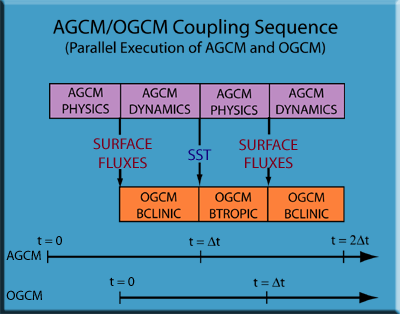
Model Coupling
The UCLA AGCM is a complex code representing many physical processes. Despite the complexity of the code, one can identify the following two major components:
- AGCM/Dynamics, which computes the evolution of the fluid flow governed by the appropriate equations (the primative equations written in finite differences).
- AGCM/Physics, which computs the effect of processes not resolved by the model's grid (such as convection on cloud scales) on processes that are resolved by the grid (such as the flow on the large scale).
The OGCM also has two major components:
- OGCM/Baroclinic, determines the deviation from the vertically averaged velocity, temperature and salinity fields.
- OGCM/Barotropic, determines the vertically averaged distributions of those fields.
The coupled atmosphere-ocean GCM, therefore, can be decomposed into four components.
When run on a single node in the AGCM and OGCM codes execute sequentially and exchange information corresponding to the air-sea interface. The AGCM is first integrated for a fixed period of time and then transfers the time-averaged sea surface temperature to the AGCM. The data transfers, including the interpolations required by differences in grid resolution between model components, are performed by a suite of coupling routines.
When run on multiple nodes, a scheme that allows the two codes to run in parallel is used. Because AGCM/Dynamics does not exchange data with the OGCM, these components can run in parallel. Further, AGCM/Physics can start as soon as OGCM/Baroclinic completes its calculation, because this includes the sea surface temperatrue, and can run in parallel with the OGCM/Barotropic. The figure below is a schematic of this running stragegy, under the assumption that overhed due to distribution can be neglected and model components running in parallel are perfectly balanced.
